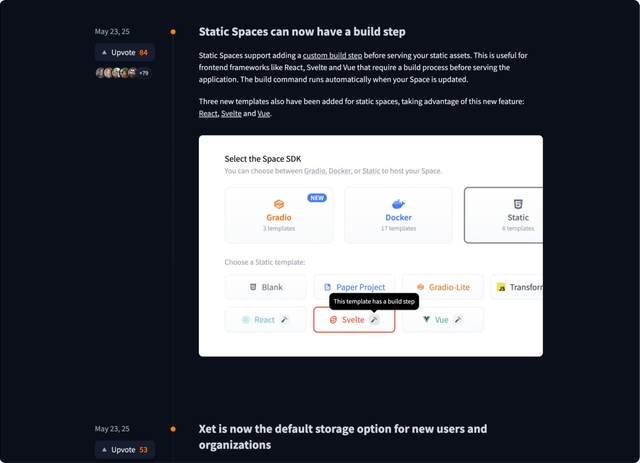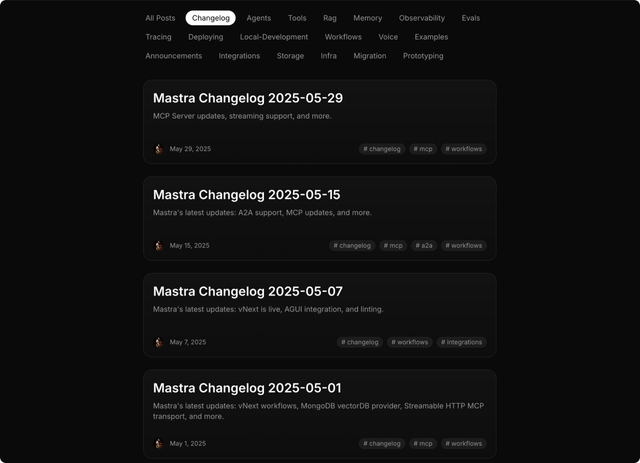How AI startups use changelogs to win developer trust

The age of AI has intensified development speed and magnified the importance of more engaging and strategic changelogs. Whether you’re building an agent-driven product, a full-stack AI company, or launching as a design founder, don’t neglect the changelog’s power to signal progress, build in public, and tell your story. In this post, we provide actionable advice from years of Evil Martians dev tools, and share real-world examples that demonstrate how the development process itself can be a way to shine a light on your product.
Changelogs and why they matter more than ever now
In this new era of AI, the pace of product evolution is faster, competition is more global, and trust is harder to earn. Thus, changelogs and public and transparent updates are now more important than ever.
(In fact, 2025 is officially the year of AI agents and full-stack AI startups, according to YC’s Requests for Startups. Sam Bhagwat, founder and CEO at Mastra, shared that over 50% of their YC batch in Winter 2025 was some kind of vertical AI agent.)
It’s important to establish that developer marketing is a no-BS, “problem vs. solution” type of marketing that must appeal to the most skeptical users—and a changelog is one of the important tools in the developer marketing toolbox. However, a changelog doesn’t have to be just a dry, technical log—it’s a public record of momentum, and a beacon that signals users, investors, and collaborators. Changelogs are also great because it gives you a source of consistency, and consistent presence is the key to success.
Hire Evil Martians
We built alongside Bolt.New and Recraft teams. Talk to us about shaping your AI product strategy
First, launch your changelog from day one
First, add a CHANGELOG.md to your repo (or post updates on your blog, X, or Discord).
As a nice example, take our client Steel. Following our advice, they started a simple changelog on X. This gave them the consistency, a constant presence, and they’ve doubled their number of GitHub stars since January.
Build in public, invite feedback, and iterate
At this stage, be sure to share updates regularly, including experiments—and especially failures. Use your changelog and public channels to invite user and community input. This is crucial for AI products that learn and adapt.
Explain “under the hood” improvements in plain language, and focus on how your customer benefits from this functionality.
Level up with design and storytelling!
Use visuals, demos, and clear UX to showcase new features and agent capabilities. To illustrate this, browser-use is a solution for connecting AI agents with the browser, and it includes several video demos showing how to develop with their product, easily accessible right from their GitHub’s README file.
Your goal is to consistently highlight outcomes and demonstrate how your AI agent or product solves real problems. To upgrade how you do this, be sure to use stories, GIFs, or short videos.
Take a look at this collection of recent updates, just from within the last month (as of the time of writing).

Hugging Face Hub

Mastra Changelog

Windsurf Editor Changelogs
Note that in the Hugging Face screen on the left, they include community vote counts in the changelog post—these are exactly the type of social features that can take changelogs to the next level of engagement.
Bonus: handling major feature launches
Let’s talk about a special case. For a major new feature release, there are a lot of great options to share your work: record a launch video, create supporting visuals, and design a full promo package. Do this, then share them across all your channels!
Check out these examples of Luma AI announcing Dream Machine and ElevenLabs announcing a conversational AI update:
Let’s point out that these formats offer a chance to show off an idealized form of your UI in a way that showcases your design work in a visually exciting way. Check out these excerpts from the videos above to get a quick glimpse of this concept:

Amplifying and scaling your signal
Let’s run down a general game plan for AI / AI Agent startups and founders.
- The MVP stage: At this point, go for scrappy updates, posts on socials, a repo file, or Discord posts. Show new agent skills or integrations.
- The growing stage: Blog posts, GitHub Releases, visuals, and feedback loops. You’re sharing your learnings from user interactions and model improvements. Move to automated changelog pages, GitHub Releases, and regular update emails as you grow. Share updates across social, newsletters, and product communities.
- Scaling further: This is where you’ll want to up things to a pro changelog page with interactive demos, promo assets, and broad distribution. Essentially, use your changelog as marketing and investor material.
At all stages, you’ll want to make sure that you’re packaging your progress for investors and partners.
Why this works across the AI landscape in 2025
A proper changelog game works for a number of reasons: market signal, consistent marketing, as a feedback engine, because you’re building in public, and this process fosters design-driven trust. Here’s why:
- You stand out in a crowded field. It’s this sort of market signal and action that shows how you’re alive, learning, and shipping.
- You’re using consistent marketing. Each update, even if small, is another chance to showcase your product.
- You end up building better agents and products by learning from real users, creating a feedback engine.
- Building in public attracts a community, talent, and early adopters who want to be part of your journey.
- In a world of black-box AI, great design and clear communication set you apart.
Finally, let’s give a quick shout out to some folks who are killing it with this. Jarred Sumner, founder of Bun is doing some awesome things with his changelog presentations, and ditto Mintlify!
Change up your changelogs
So, start your changelog today—post it on your socials, email it, or just add a line to your repo. In the AI era, the world is watching. And if you need help ideating, or creating your posts—let’s talk!




